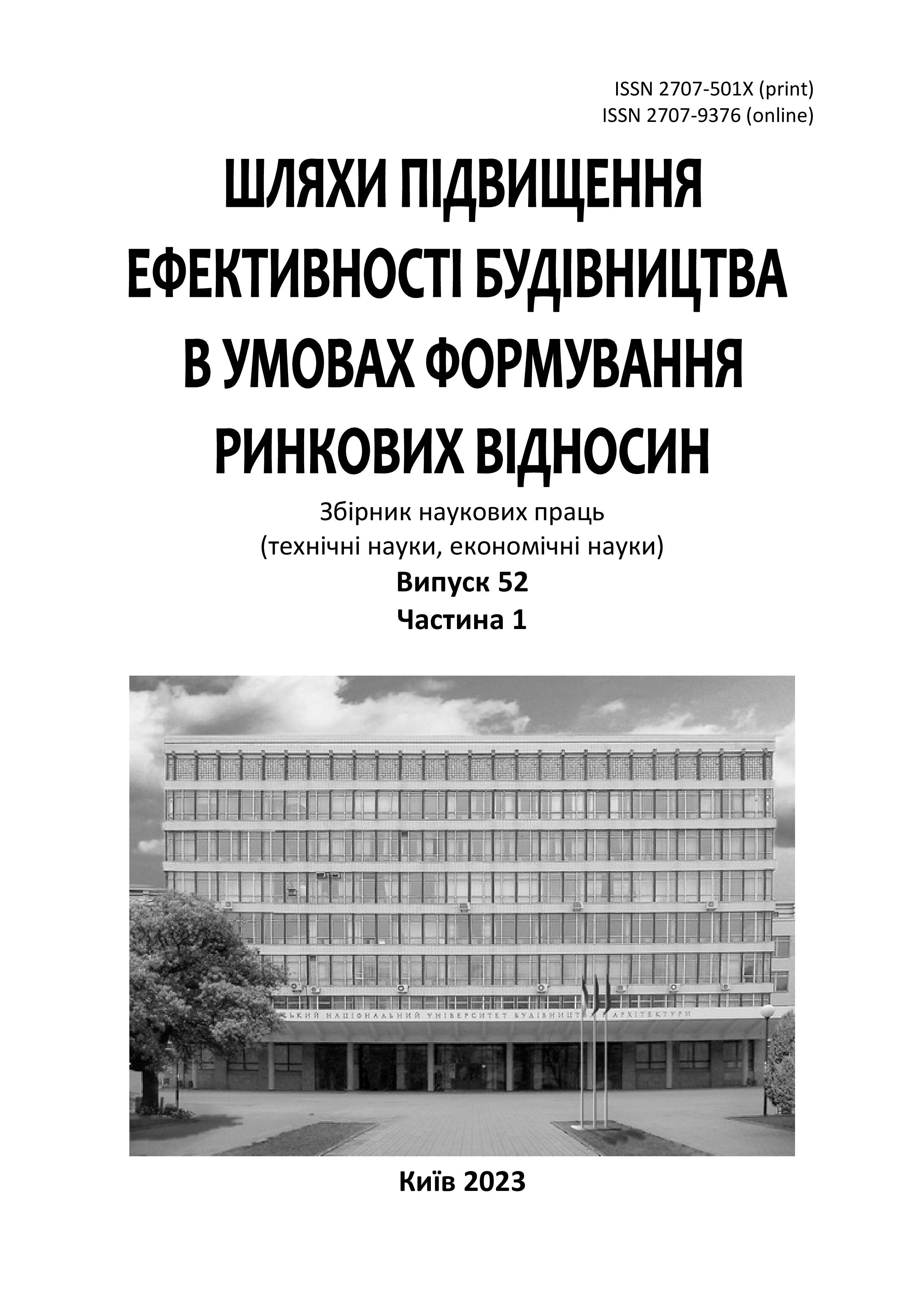The influence of the period of collection of flows in industrial construction without using additional labor resources
DOI:
https://doi.org/10.32347/2707-501x.2023.52(1).171-180Keywords:
energy-saving technologies of building construction, resource-saving technologies, balanced systems of flow expansion and contraction periods, flow optimization, serial-parallel method, variant design, technologically similar works, rank matrix with priority on the work frontAbstract
In the non-rhythmic flow construction of industrial facilities, there are processes with a reserve of unused labor resources on works and grabs, which affect the term of work (the period of deployment of flows). The analysis of non-rhythmic works showed that they have works with a period of curtailment of flows of greater than the smallest value and they have a reserve of unused labor resources, but do not affect the terms of execution of works.
It is proposed to reduce the duration of non-rhythmic flow works on technologically identical processes by using unused labor resources on works with an increased flow curtailment period on interdependent grippers.
Performed preliminary studies showed that interdependent grabs for parallel work are determined by a rank matrix with priority on the OVRR front. These jobs with increased flow deployment period showed that redistributing work volumes between two jobs reduces the duration of jobs. In previous studies, the redistribution of the volume between these two works has an abstract nature without determining the technological homogeneity of the two works. The redistribution of non-rhythmic work volumes is forged in it into technologically identical types of occupations. For processes with an increased period of curtailment of flows, it is proposed to balance two jobs by a parallel method of performing work on technologically identical types of work without the use of additional labor resources.
Optimizing the reduction of the construction period involves the use of parallel methods on two technologically identical works with an increased flow curtailment period. The example shows examples of balancing two jobs by using special and universal (excavator) machines with specialized specialists or complex crews. Technical and economic indicators were determined for the performed optimization.
References
Афанасьев В.А. Поточная организация строительства. Л.: Стройиздат Ленингр. отд-ние, 1990. 303 с.
Григоровський П.Є., Броневицький А.П., Мурасьова О.В., Григоровський А.П. Аналіз світового досвіду та сучасних технічних рішень будівництва швидкоспоруджуваних житлових будинків. Нові технології в будівництві. 2022. № 41. С. 10-20. URL: http://www.ntinbuilding.ndibv.org.ua/archive/2022/41_2022/2.pdf
Гуляницький Л.Ф., Мулеса О.Ю. Прикладні методи комбінаторної оптимізації: навч. посіб. К.: Видавничо-поліграфічний центр "Київський університет", 2016. 33 с. URL: https://sau.nmu.org.ua/ua/osvita/metod/magistr/MDO_pidruchnyk.pdf
Визначення тривалості будівництва об’єктів. ДСТУ Б.А.3.1 -22:2013. К.: Мінрегіон України, 2014. 43 с.(Державний стандарт України). URL: https://dbn.co.ua/load/normativy/dstu/dstu_b_a_3_1_22/5-1-0-1109.
В Ухані завершили будівництво лікарні для пацієнтів з коронавірусом. 2020. URL: https://lb.ua/world/2020/02/02/448778_uhani_zavershili_stroitelstvo.html
Іванейко І.Д., Мудрий І.Б., Олексів Ю.М. Формування та ефективність технологічних конструктивних рішень стрічкових фундаментів зведених із-за меж котловану. Сучасні технології та методи розрахунків у будівництві. 2015. Вип. 3. С. 79-92.
Іванейко І.Д., Іванейко М.М., Вишневецький Р.М.. Спорудження збірних фундаментів у складних котлованах. Сучасні технології та методи розрахунків у будівництві. 2017. Вип. 8. С. 53-61.
Іванейко І.Д., Олексів Ю.М. Збалансування неритмічних потоків комплексно-механізованими бригадами. Містобудування та територіальне планування. 2016. Вип. 62. С. 222-227.
Мудрий І.І. Порядок та реалізація принципів формування ефективного комплекту стрілових кранів. Управління розвитком складних систем. 2017. № 30. С. 156 – 162. URL: http://urss.knuba.edu.ua/files/zbirnyk-30/23.pdf
Мудрий І.Б. Технології спорудження фундаментів з урахуванням функціонального простору стрілових кранів: автореф. дис. … канд. техн. наук: 05.23.08. К.: КНУБА, 2011. 20 с.
Організація будівництва: підручник / С.А.Ушацький, Ю.П.Шейко, Г.М. Тригер та ін.: За редакцією С.А. Ушацькоко. К.: Кондор, 2007. 521 с.
Шумаков І.В. Теоретико-методологічні принципи формування організаційно-технологічних рішень зведення підземної частини цивільних будівель: автореф. дис. д – ра техн. наук. Харків: ХНУБА, 2015. 35 с. URL: http://aleph.lsl.lviv.ua:8991/F/?func=direct&doc_number=000499960&local_.
Шумаков И.В., Микаутадзе Р.И., Ляхов И.И. Оптимизационные тенденции в прогнозировании продолжительности строительства. Науковий вісник будівництва. 2018. Т.91. №1. С. 115-121.
Hicks S.J., Lawson R.M., Rackham J.W., Fordham P. Comparative Structure Cost of Modern Commercial Buildings (Sec.Ed.). The Steel Construction Institute, 2004. URL: https://www.steelconstruction.info/images/d/df/SCI_P137.pdf
Ivaneiko I., Oleksiv Yu. Optimization of deployment periods of non-rhythmic flow-lines by complex mechanized machines. Theory and Building Practice. 2022. Vol. 4, № 2, 75-82. https://doi.org/10.23939/jtbp2022.02.075
Pan J.C., Chen J., Chao С. Minimizing tardiness in a two-machine flow-shop. Computers & Operations Research. 2002. № 29. Рр. 869–875.
Schaller J. Note on minimizing total tardiness in a two-machine flowshop. Computers & Operations Research. 2005. № 32(12). Рр. 3273–3281.
Maj Tadeusz. Organszacja budowy. WSIP, 2010. 220 р.
Using modern methods of construction to build homes more quickly and efficiently: Report by National Audit Office, 2005. 29 p. URL: https://www.nao.org.uk/wp-content/uploads/2005/11/mmc.pdf
Downloads
Published
How to Cite
Issue
Section
License

This work is licensed under a Creative Commons Attribution 4.0 International License.
Authors who publish with this journal agree to the following terms:
- Authors retain copyright and grant the journal right of first publication with the work simultaneously licensed under a Creative Commons Attribution License that allows others to share the work with an acknowledgement of the work's authorship and initial publication in this journal.
- Authors are able to enter into separate, additional contractual arrangements for the non-exclusive distribution of the journal's published version of the work (e.g., post it to an institutional repository or publish it in a book), with an acknowledgement of its initial publication in this journal.
- Authors are permitted and encouraged to post their work online (e.g., in institutional repositories or on their website) prior to and during the submission process, as it can lead to productive exchanges, as well as earlier and greater citation of published work (See The Effect of Open Access).

